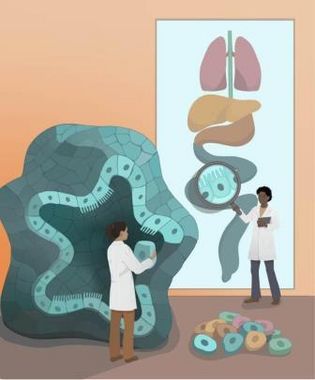Can organoids recapitulate human development?
The Camp lab at IOB (IOB Human Retina and Organoid Development Group) and collaborators in the labs of Jason Spence at the University of Michigan and Barbara Treutlein at the ETH Zürich established a single-cell transcriptome atlas from multiple developing human organs. They combined the cell atlas with organoid technologies to see how well organoids recapitulate actual human development, and to explore mechanisms underlying the generation of organ-specific stem cells. This exciting work is now published in Cell.
One great value of a reference atlas is to provide a quantitative description of all cell types or cell states present in a developing organ. “Our study focuses on the developing respiratory and gastrointestinal tracts. We catalog cell types and use the data to eavesdrop on communication between stem cells and their niche”, says Gray Camp, Head of the IOB Human Retina and Organoid Development Group, and senior author of the publication in Cell. The work also provides insight into potential disease mechanisms by identifying cell types that express disease-associated genes. The authors provide a public interactive web browser (http://guttuber.iob.ch/app/) to enhance data access and assist with user-friendly data exploration.
Human organoids can be predictive of development
The reference cell atlas is also a valuable search space to understand the fidelity of engineered organoids derived from human pluripotent stem cells. In this work, the authors grew intestinal organoids in multiple culture conditions and also from cells that contained a mutation in a master regulator of intestinal development. “Our data shows, with extraordinary resolution, that human organoids can be predictive of development. The organoid cells were highly similar to the reference counterparts, and the perturbations we applied to the organoids gave mechanistic insight into the developmental biology of human intestinal stem cells,” says Gray Camp. Altogether, the data and analyses provide a rich resource for understanding human developmental biology.
Major resource for engineering next generation organoids
“This is great teamwork. We create a framework for integrating complex primary tissue and organoid datasets, and we show that organoids can provide new insights that would otherwise be inaccessible”, says Qianhui Yu, lead author of the manuscript and postdoctoral researcher in the IOB Human Retina and Organoid Development Group.
The reference atlas will serve as a major resource for engineering next generation organoids across different organs, and for calibrating protocol modifications. Considering human primary developing tissues are limited resources, the in vitro organoid system provides a reliable, reproducible and genetically tractable alternative. Future work with organoid disease avatars from patient-specific cells promises to bring new insights into human disorders.
Original publication
Charting human development using a multi-endodermal organ atlas and organoid models
Qianhui Yu, Umut Kilik, Emily M. Holloway, Barbara Treutlein, Jason R. Spence, J. Gray Camp
Cell (online May 20) 2021 https://doi.org/10.1016/j.cell.2021.04.028
About the artwork:
The image depicts how scientists are working together to learn how to build better tissue models of human development by comparisons to high-resolution reference cell atlases from primary tissues.
In the paper, Yu, Kilik, and Holloway et al. chart the development of multiple human endoderm-derived organs using single-cell transcriptomics, and use the atlas to improve intestinal organoid culture methods from pluripotent stem cells.
The authors also show how organoid technologies can be used to understand aspects of human development that are difficult to access using primary tissues.

